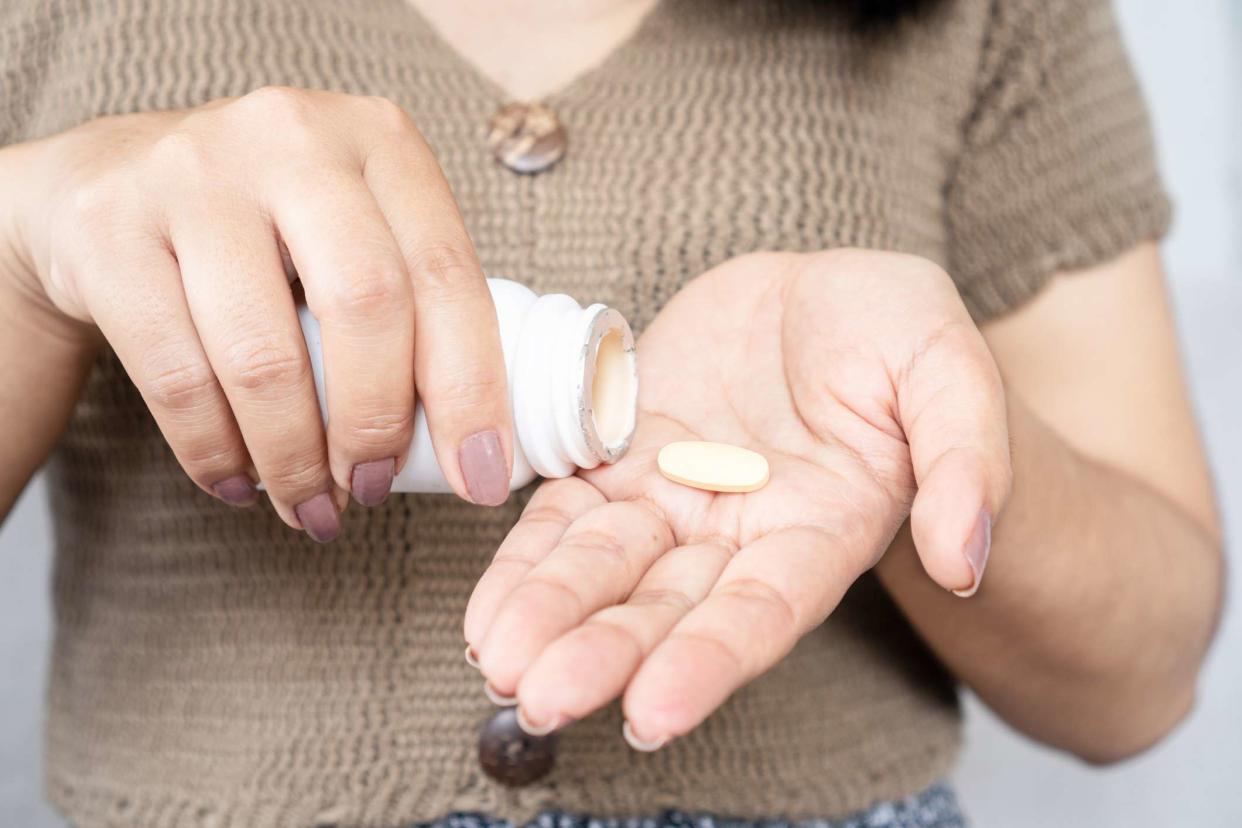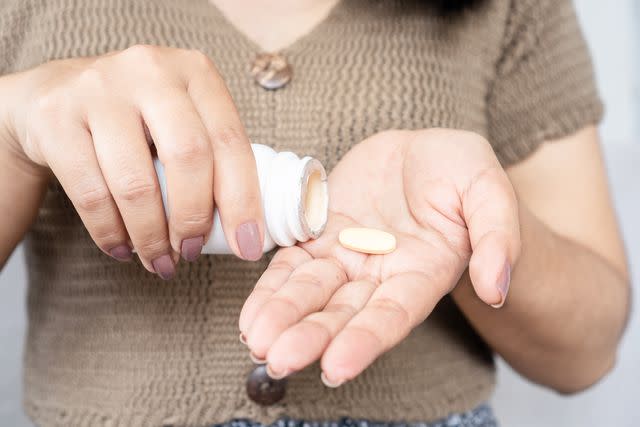Lifestyle Changes to Prevent and Manage Osteoporosis

Doucefleur / Getty Images
Medically reviewed by Stella Bard, MD
Osteoporosis makes your bones more fragile over time, which can be challenging to cope with on a daily basis. Fortunately, treatment options like prescription medications and hormone therapy are available—and can be supplemented with lifestyle changes.
Certain diet and exercise modifications, along with taking steps to prevent bone fractures and injuries, can help improve osteoporosis symptoms and your quality of life. This article provides an overview of how exercising, eating healthy, and preventing falls help support bone health.

Doucefleur / Getty Images
Risk Factors and Causes of Osteoporosis
Anyone can develop osteoporosis, which happens when bone mass and bone mineral density breaks down. But it’s more likely to occur in people with certain risk factors.
For example, your chances of developing osteoporosis increase with the following:
Older age
Female sex assigned at birth
Thin-boned, slender body frame
Family history of osteoporosis
Low levels of estrogen or testosterone
Consuming a diet low in calcium and vitamin D
Using certain medications, such as glucocorticoids, proton pump inhibitors, and more
Family history of osteoporosis
Certain medical conditions like rheumatoid arthritis, gastrointestinal diseases, and more
Smoking, heavy alcohol drinking, and low physical activity levels
Healthy Diet for Osteoporosis
Simply put, the food you eat affects your bone health. There are a few specific nutrients that are essential for an osteoporosis diet.
Calcium
Calcium is a mineral that your body needs to help maintain healthy bones. As you age or develop osteoporosis, calcium can be reabsorbed by the body. This makes your bones thinner and weaker instead of promoting good bone health.
For this reason, your healthcare provider will likely recommend adding plenty of this nutrient to your diet with foods or a supplement, if needed.
Vitamin D
Getting enough vitamin D in your diet helps your body absorb calcium. If you don't get enough of either, your bones become more fragile and likely to fracture.
While vitamin D can also be created in the body through sun exposure, a healthcare provider will likely recommend a supplement or a diet bolstered with fish, eggs, cheese, and more.
Foods to Eat
If your diet is not providing your body with enough calcium and vitamin D, the first step is carefully adding in good sources of these key nutrients.
For example, calcium is found in:
Dairy products
Dark leafy green vegetables
Broccoli
Salmon
Sardines
Calcium-fortified foods, like tofu, orange juice, cereals, breads, and soy milk
Foods that contain vitamin D include:
Fatty fish
Eggs
Liver
Vitamin D–fortified foods, like milk and cereals
Federal guidelines recommend that women over the age of 50 and men over the age of 70 get a daily calcium intake of 1,200 milligrams (mg) and a daily vitamin D intake of 800 international units (IU). A vitamin supplement may be recommended by your healthcare provider if you're not able to make dietary modifications.
(Note that when research and health authorities are cited, the terms for sex and gender from the source are used.)
Foods to Avoid
There also are foods that you'll want to stay away from. Experts recommend avoiding the following foods if you have osteoporosis:
Salty foods (including processed or canned foods that often contain high amounts of sodium)
Colas
Wheat bran
Foods and drinks with added sugar
Red meat and other sources of saturated fat
To help manage your osteoporosis, include foods that support bone health and avoid added sugar, sodium, and saturated fat.
Exercise Regularly
While it may seem counterintuitive, exercising regularly is important for helping preserve bone density and reducing the risk of a bone fracture when you have osteoporosis. To see the benefits, experts recommend a mix of weight-bearing exercises that force the body to work against gravity roughly three times a week.
Low-Impact Weight-Bearing Exercises
Incorporating low-impact weight-bearing and resistance exercises into your routine will place less strain on your joints and is a good place to start.
For example, you might consider including osteoporosis-safe physical activities like:
Hiking
Walking
Climbing stairs
Tennis
Dancing
Lifting light weights
Light jogging
Swimming
Bicycling
High-Impact Weight-Bearing Exercises
High-impact or high-intensity exercises put stress on the joints, and typically involve activities like running or jumping. These types of activities are usually not recommended for people with osteoporosis because of the risk for fractures or other injuries.
If you're interested in starting or continuing any high-impact exercises after being diagnosed with osteoporosis, ask your healthcare provider if you're cleared to do so.
Talk to Your Healthcare Provider About Exercise
An exercise routine is a key part of an osteoporosis treatment plan. Just be sure to discuss with your healthcare provider which exercises will be safest for you based on your specific osteoporosis case.
Limit Alcohol, Smoking, and Caffeine
As with food, people with osteoporosis should also be mindful of the other substances they consume—like alcohol, tobacco, and caffeine.
Here's what experts recommend:
Drinking alcohol in moderation or not at all, as it appears to block the body's ability to regenerate and strengthen bones.
Avoiding secondhand smoke or quitting smoking, as research shows tobacco use can increase the risk of bone fractures.
Limiting caffeine, which may interfere with bone metabolism and calcium absorption if consumed in larger amounts.
Lifestyle Changes Plus Medication
Remember that incorporating these lifestyle changes is meant to supplement osteoporosis medication and become a part of your treatment plan—not replace any prescriptions or therapies that your healthcare provider has recommended.
Prevent Falls and Fractures
It's important to reduce the risk of breaking or fracturing a bone in the first place by preventing falls. For people with osteoporosis, a bone break might not be able to heal properly and can lead to additional pain.
Improve Balance
Having good balance helps keep you steady, reducing the risk of a fall. To improve your balance, consider the following:
Incorporate exercises that promote strength and balance, such as yoga, Pilates, tai chi, weight lifting, or using resistance bands.
When standing up from sitting or lying down, do so slowly or with support.
Don't be afraid to use a cane or walker if it makes you feel steadier.
Take extra caution on stairs, particularly outside during wintry weather.
Remove Fall Hazards Around the House
It's a good idea to set up your house in a way that promotes open walkways and room to get around, if possible. In addition to arranging furniture so that items are not in your way, you might also do the following:
Remove throw rugs, and replace them with nonskid mats or carpet strips.
Make sure carpets are securely fixed to the floor.
Keep electrical cords tucked away.
Ensure there is good lighting, particularly in hallways and by staircases.
Consider installing handrails on stairs and in the bathroom.
Assistive Devices
Tools are available to install or keep handy if you fall. These include:
Using an emergency response system that involves pushing a button on a necklace or bracelet to alert 911
Setting up a smart home device or smartwatch that can quickly connect you to emergency assistance
Carrying a charged cell phone with you around the house
Using motion-activated lights that automatically turn on
Work With Your Healthcare Provider
Your healthcare provider is an important part of your osteoporosis treatment plan. Together, you can work to find the best methods for coping with osteoporosis—without sacrificing your quality of life.
In addition to visiting your healthcare provider for regular checkups, don't be afraid to ask a question if you're having an issue between visits. Many factors can affect bone health or increase fall risk, including medications, new or ongoing health conditions, and changes in your living environment.
Coping with osteoporosis can be a challenging journey, but know that there are many different treatment options and support mechanisms available along the way. In addition to incorporating lifestyle changes for physical improvement and ease, you might also consider resources for emotional support when navigating this life change.
Summary
Lifestyle changes like exercising, eating healthy, and preventing falls are important parts of an osteoporosis treatment plan. This includes eating a diet rich in vitamin D and calcium, starting a bone-strengthening exercise routine, and incorporating some tweaks around the house to reduce the likelihood of falling.
Always check with a healthcare provider first for the best options to safely manage your osteoporosis.
Frequently Asked Questions
Which vitamins and supplements are best for osteoporosis?
Studies show that calcium, vitamin D, magnesium, vitamin K, and soy isoflavones can be helpful in supporting osteoporosis treatment. Check with a healthcare provider about the best combination and doses for your individual case.
Can lifestyle changes reverse the effects of osteoporosis?
Incorporating lifestyle changes like exercising more, eating a diet full of helpful vitamins, and avoiding drinking and smoking can help you manage osteoporosis, but they won't reverse the condition. In addition, a healthcare provider can recommend medications for your treatment plan to help slow bone loss and rebuild bone density.
How long does it take to improve bone density?
Bone density improvement is different for everyone, so there's no set time frame. Exercise, nutrition, and medication are crucial parts of an osteoporosis treatment plan to make this happen. For reference, at least one study has suggested that two years of regular, osteoporosis-specific exercise helped improve bone density in certain people.

